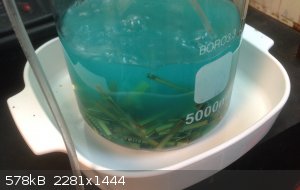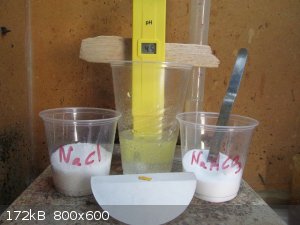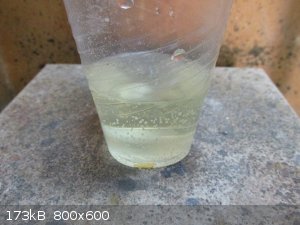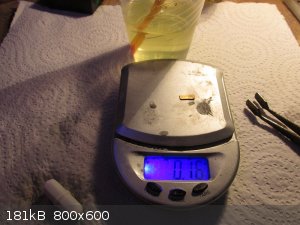| Pages:
1
..
5
6
7
8
9 |
kadriver
Hazard to Others
  
Posts: 196
Registered: 7-11-2012
Location: United States
Member Is Offline
Mood: Thankful
|
|
Quote: Originally posted by aga  |
The [M] thing is how many Moles there are.
A Mole is defined as 6.022 x 10<sup>23</sup>
Usually written as M, [M] or Mol to avoid embarassment, or confusion with moles.
So if you dissolve 39.99g of totally pure NaOH in 1 litre of totally pure water (to make a 1.0M solution) then there are about
602200000000000000000000 molecules of NaOH in that water.
The number is too big to handle easily, so we use the Mol as a measure instead.
[Edited on 12-10-2015 by aga] |
Avogadro? I recognize that from Khan Academy. I studied a little there. Found out about the S-block, the P-block and the D-block. Also how to find the
electron configuration of the elements off the periodic table.
I've got to get off my butt and enroll in some chemistry classes at our community college. I'd like to be able to know what's going on inside those
beakers at the atomic level.
kadriver
|
|
|
kadriver
Hazard to Others
  
Posts: 196
Registered: 7-11-2012
Location: United States
Member Is Offline
Mood: Thankful
|
|
Quote: Originally posted by j_sum1  | | Developments have been thick and fast here and I will admit to not having read the whole thread or viewed all of the videos. But, in my view, this is
really exciting. Please, when done, as well as the videos, do a write-up in prepublication. This great work deserves all the recognition it can get.
And as for school projects, I can really see it working. I am going to put it on the list of suggestions for my students next year.
|
I've got a friend that is a Mathematics Professor at The College of Charleston. He has published several papers with new discoveries in mathematics
(polynomial zeta function gamma stuff). He's got some videos on YouTube but it literally sounds like Greek to listen to them, even though they are
done in English! He could advise on the format, and you chemistry folks could edit the content. Is it possible to submit such a paper for publication?
I'm no academic with just an undergrad degree in aviation from Embry Riddle. That would be cool!
https://www.youtube.com/watch?v=2i5PQiueW_8
I've not seen or heard of doing this process in this way any place. Especially the use of vitamin C to precipitate the gold. But I have only been
refining precious metals as a hobby for about 5 years and then only at an amateur level.
I can't wait to get into refining platinum group metals and making some videos. There is MUCH more chemistry involved. I am particularly interested in
the Gilchrist Hydrolysis of platinum where sodium bromate is used to form the hydroxides of the sister metals leaving the pure platinum "mother
liquor" that can be drawn off and then precipitated into really pure platinum salt that is calcined in a fused Quartz dish to form pure platinum
sponge. I've got everything to do it, just lack the know-how.
Colloidal gold is very pretty, but not very easy to collect (it goes right through even the finest filter paper). As recommended by deltaH, boiling
during precipitation to coalesce the colloidal gold is new stuff to me also. Good stuff here. It has pumped new enthusiasm into my hobby, which was
becoming sort of like work, or a job.
kadriver
|
|
|
kadriver
Hazard to Others
  
Posts: 196
Registered: 7-11-2012
Location: United States
Member Is Offline
Mood: Thankful
|
|
Here is a snapshot of the experiment after about 24 hours. It was crystal clear and blue in color. It turned cloudy after I stirred it. There are just
a few gold foils that have been released from the fingers with the aerator in operation the whole time.

|
|
|
deltaH
Dangerous source of unreferenced speculation
    
Posts: 1663
Registered: 30-9-2013
Location: South Africa
Member Is Offline
Mood: Heavily protonated
|
|
Quote: Originally posted by kadriver  | Quote: Originally posted by deltaH  |
You can actually substitute the lye which is corrosive with sodium bicarbonate, then it can become a junior lab project  Kid's love adding bicarb to vinegar after all!!! Kid's love adding bicarb to vinegar after all!!!
|
Do you think that the bicarbonate would do? If you think it will work then I'll use it instead of lye.
I shot some more video at noon on Sunday, I'll get some more footage at midnight. There were just a few foils at noon today, Sunday.
|
The only purpose of the lye was to raise the pH of neat vinegar (~3?) a little higher to 4.5 by making some sodium acetate, but pH 4.5 is still
acidic, so you can use much weaker bases to achieve it. Sodium bicarbofinate will work and generate much fizzing by making CO2. Washing soda (sodium
carbonate) would also work and generate half as much fizzing.
The important thing is to get to pH 4.5-5 by hook or by crook 
Remember, this is only an educated guess.
|
|
|
deltaH
Dangerous source of unreferenced speculation
    
Posts: 1663
Registered: 30-9-2013
Location: South Africa
Member Is Offline
Mood: Heavily protonated
|
|
| Quote: | | Colloidal gold is very pretty, but not very easy to collect (it goes right through even the finest filter paper). As recommended by deltaH, boiling
during precipitation to coalesce the colloidal gold is new stuff to me also. Good stuff here. It has pumped new enthusiasm into my hobby, which was
becoming sort of like work, or a job. |
Some more on this... colloidal particles in a solution are kept from coellescing by charging up their surface so that the particles in solution repel
each other electrostatically. Often this is done with an organic compound that absorbs strongly on the surface. Ascorbic acid, vitamin C, may well
play this role.
But colloidal solutions are often metastable, so I'm hoping that heat, as with many metastable things, will shift it to a more stable state which is
that of larger metal particles (in the same way that heat can collapse micelles, another type of colloidal metastable state).
I strongly suggest you do this on the test tube scale first to determine which conditions precipitates the gold nicely before doing it to the rest of
the volume of your solution. Remember after boiling it for some time (I don't really know what is long enough, might be instant, might need an hour?),
place it aside vertically overnight to see if it settles out. I also do not know how fast the settling will be, might even happen immediately as well,
but if not, leave it overnight.
|
|
|
deltaH
Dangerous source of unreferenced speculation
    
Posts: 1663
Registered: 30-9-2013
Location: South Africa
Member Is Offline
Mood: Heavily protonated
|
|
[As an aside] While bulk gold is fairly inert, nanosized gold particles are very active catalysts for some reactions, typically oxidations. It's a
classic example of the big differences that can occur in going from bulk materials to nano-sized materials.
[/end fact of the day]
|
|
|
kadriver
Hazard to Others
  
Posts: 196
Registered: 7-11-2012
Location: United States
Member Is Offline
Mood: Thankful
|
|
Quote: Originally posted by deltaH  |
Please try to cut out HCl completely throughout, then we would have really accomplished something here. For the gold dissolution step, I strongly
suggest you raise the pH of the salted vinegar BEFORE adding bleach with 0.2M sodium hydroxide solution to 4.5 so that one avoids the copious
production of chlorine gas (hopefully).
You could finish off everything with an ascorbic acid reduction to make the process really Green and interesting. Like Bert showed,
it's cheap stuff in semi-bulk scale.
|
I ordered 500 grams of ascorbic acid for the reduction. But I think there might be a problem with this.
The vinegar-salt-peroxide solution will have dissolved copper and possibly some other metals in solution with the gold after dissolving the foils with
bleach.
The ascorbic acid will likely precipitate these other metals with the gold and thus contaminate the pure gold.
Not a problem, we'll just have karat gold instead of pure gold.
Or, I could do this;
1) prepare a fresh batch of vinegar-salt-peroxide (or just vinegar and salt)
2) add the thoroughly rinsed gold foils to the fresh batch of solution
3) raise pH to 4.5 with sodium bicarbonate to eliminate production of chlorine as per deltaH
4) dissolve the foils by adding bleach to the foils in the bicarbonate adjusted solution
5) precipitate the gold with ascorbic acid - boil to coalesce - settle overnight
6) collect the gold in a filter paper
7) melt the gold into a bead
I may try this procedure off camera with some pure gold powder just to see if it works. If I can't get it to work with some gold powder then it
probably won't work with foils either.
If this off camera experiment with gold powder using the seven-step process above does work then I'll complete the video of the experiment with the
foils.
But, if I can't get it to work, or if I have some other problem then I'll revert back to using HCl and bleach so that I can publish the video as
scheduled (I've already put part one of two out there).
If anyone has any input then that would be greatly appreciated.
This evening at the 48 hour point the foils are about 65 to 70 percent lifted from the fingers (estimated). They will probably be ready by the 72 hour
mark. I have footage of the bubbler at each 12 hour interval (4 shots so far) so the progress can be viewed during the video.
kadriver
|
|
|
deltaH
Dangerous source of unreferenced speculation
    
Posts: 1663
Registered: 30-9-2013
Location: South Africa
Member Is Offline
Mood: Heavily protonated
|
|
That's great kadriver. Rinsing the gold should eliminate the copper contamination (crosses fingers).
I'm very excited and hope it works for this will be first complete and videoed process using the OTC green reagents.
[Edited on 13-10-2015 by deltaH]
|
|
|
aga
Forum Drunkard
    
Posts: 7030
Registered: 25-3-2014
Member Is Offline
|
|
Local Holidays are over and there are several parcels waiting in the local town.
Hopefully there will be some Gold !
For the non-videoed theoretical stuff, 2g of .999 gold will be available.
I'll cut it up a bit, but not more machining than that (as it takes a lot of time).
Suggestion: we take a 1 g bar, cut it in half and experiment on each 0.5g bar in turn to fine-tune the dissolution.
Elemental Copper and Tin can be aded to simulate more real-world applications.
Once tuned, cut the other bar in half and subject one to the new 'green' process and the other to aqua regia dissolution.
Melting the results back into gold lumps should not pose any problem.
Non-OTC Reagents avalable :
20% HCl
35% HNO3 (can distill some 98% if needed)
NaOH
KOH
(plenty more, just not sure what is needed)
OTC stuff:
White vinegar : 8%
Sodium Bicarbonate
Sodium Metabisulphite is on hand for the precipitation plus borax (or is it boric acid?) for the melt.
For the 'fine tuning' i do not mind if the gold is lost, so we can cut the first bar down into 0.2g chunks (or less) and test the process at least 5
times if not 10, varying the parameters each time.
Over to you deltaH for the process(es) and ingredients.
|
|
|
deltaH
Dangerous source of unreferenced speculation
    
Posts: 1663
Registered: 30-9-2013
Location: South Africa
Member Is Offline
Mood: Heavily protonated
|
|
Place 40ml of acetic acid in a small beaker and saturate it with an excess of salt (sodium chloride). After stirring and allowing it to settle, decant
the supernatant liquid into a clean flask. Drop in a small piece of pH indicator paper and raise the pH to 4-5 by mixing in spatula-tip-fulls
of sodium bicarbonate, waiting for effervescence to subside between each addition. Gravity filter the solution if cloudy when complete.
Now cut approximately 1/5th of your gold 'bar' (~0.2g) with a pair of scissors and add to your beaker containing the previously prepared buffer
solution. Then add 10ml of additive-free (perfumes, surfactants, etc.) household bleach and magnetically stir for an extended period of time.
Record detailed observations and depending on the results, we can devise changes as required.
We will need a comparative test with aqua regia, but that's for a later stage.
Thank you for your efforts aga!
[Edited on 13-10-2015 by deltaH]
|
|
|
aga
Forum Drunkard
    
Posts: 7030
Registered: 25-3-2014
Member Is Offline
|
|
Additive free ?
Surely they ALL have additives.
We can only go with OTC bleach, so it will have to be the same stuff that successfully made chloroform (i.e has hypo in it).
|
|
|
deltaH
Dangerous source of unreferenced speculation
    
Posts: 1663
Registered: 30-9-2013
Location: South Africa
Member Is Offline
Mood: Heavily protonated
|
|
By us each brand has some 'plain' version that's just sodium hypochlorite and salt.
Baby sterilising solution is another way to go for simple sodium hypochlorite and salt, except the new chlorine-free ones based on
dimethyldidecylammonium chloride. YUCH! Give me chlorine anyday 
|
|
|
aga
Forum Drunkard
    
Posts: 7030
Registered: 25-3-2014
Member Is Offline
|
|
OTC bottle of bleach it is then ...
Be aware that Baby sterlising solution is not intended for use on the actual Baby.
|
|
|
deltaH
Dangerous source of unreferenced speculation
    
Posts: 1663
Registered: 30-9-2013
Location: South Africa
Member Is Offline
Mood: Heavily protonated
|
|
lol
|
|
|
Little_Ghost_again
National Hazard
   
Posts: 985
Registered: 16-9-2014
Member Is Offline
Mood: Baffled
|
|
Quote: Originally posted by aga  | OTC bottle of bleach it is then ...
Be aware that Baby sterlising solution is not intended for use on the actual Baby. |
That sounds as daft as car shampoo is not for use on cars  . So let me get this
straight.... Baby bleach is bleach for beginners? . So let me get this
straight.... Baby bleach is bleach for beginners?
Dont ask me, I only know enough to be dangerous
|
|
|
kadriver
Hazard to Others
  
Posts: 196
Registered: 7-11-2012
Location: United States
Member Is Offline
Mood: Thankful
|
|
Quote: Originally posted by deltaH  |
Now cut approximately 1/5th of your gold 'bar' (~0.2g) with a pair of scissors and add to your beaker containing the previously prepared buffer
solution. Then add 10ml of additive-free (perfumes, surfactants, etc.) household bleach and magnetically stir for an extended period of time.
|
Then check for the presence of chlorine gas evolving from the reaction?
I know that the prediction is no chlorine gas here, but, "making predictions is risky business - especially if it's about the future." - Yogi Berra.
It is possible that you could start making chlorine gas. I'd have a plan in place to deal with it ahead of time just in case it happens.
I washed the blue precipitate from my previous experiment and to my surprise, found quite a bit of gold foils in the bottom of the container. I'm
going to follow the procedure above using these newly discovered foils and see if I can get a result on video and post it.
I'll do the bleach reaction several feet from my "fume cupboard" as a precaution. If I start to smell chlorine I'll quickly move the reaction to the
cupboard. If there is no chlorine smell then the experiment will be good to go.
kadriver
|
|
|
deltaH
Dangerous source of unreferenced speculation
    
Posts: 1663
Registered: 30-9-2013
Location: South Africa
Member Is Offline
Mood: Heavily protonated
|
|
Please, this must be strictly done in a fume cupboard before we can confirm that it doesn't evolve a lot of chlorine, not several feet from it.
Also, even if it doesn't evolve chlorine by bubbling, it might still smell strongly of it as there should be some in solution!
|
|
|
kadriver
Hazard to Others
  
Posts: 196
Registered: 7-11-2012
Location: United States
Member Is Offline
Mood: Thankful
|
|
In the fume cupboard - got it.
|
|
|
aga
Forum Drunkard
    
Posts: 7030
Registered: 25-3-2014
Member Is Offline
|
|
Gold has arrived in the form of perfectly formed 1g ingots.
Now to damage, deface and dissolve them 
|
|
|
kadriver
Hazard to Others
  
Posts: 196
Registered: 7-11-2012
Location: United States
Member Is Offline
Mood: Thankful
|
|
Quote: Originally posted by aga  | Gold has arrived in the form of perfectly formed 1g ingots.
Now to damage, deface and dissolve them  |
Dissolving the pieces of ingot is going to take much longer than foils as the foils are just microns in thickness.
|
|
|
MrHomeScientist
International Hazard
    
Posts: 1806
Registered: 24-10-2010
Location: Flerovium
Member Is Offline
Mood: No Mood
|
|
Remember that gold is extremely soft and ductile - you can easily flatten the ingots with gentle taps from a hammer on a hard surface. Then cut (or
tear!) to size. Shouldn't be all that difficult.
Also ascorbic acid will definitely precipitate base metals. I did just that as part of a 'copper cycle' lab I did with local kids. At that point they
had a solution of copper(II) chloride, and simply adding a solution of vitamin C causes lots of very nice looking copper powder to precipitate. So if
there's any copper (or likely lead, tin, etc. too) contamination it will come down with your gold. Easily fixed with later purification I'm sure, but
something to be aware of.
|
|
|
aga
Forum Drunkard
    
Posts: 7030
Registered: 25-3-2014
Member Is Offline
|
|
40ml of 8w% OTC white vinegar was put in a plastic cup with a stirbar.
With stirring, NaCl table salt was added until no more would dissolve at room termperature (approx 25 C today).
At no point was Heating employed (plastic cup, duh !).
14.01g of NaCl was added in total.
The saturated vinegar/salt solution was poured off from the excess salt crystals.
Filtering was unnecessary.
The Stirbar was retrieved, washed and added to the liquid.
A digital pH meter was added and showed a pH of 1.8 at this time.
A wooden support was used to raise the pH meter to allow some space for the stirbar to move.
In small portions OTC (NaHCO3) sodium bicarbonate was added until a reading of pH 4.5 was obtained.
4.60g of NaHCO3 was used to achieve this pH.
10ml of OTC bleach was added.
Immediately there was a pungent smell which is exactly like that of dry TCCA, so probably a mix of HCl and Cl2.
There was no bubbling or obvious gassing occurring, and the temperature did not change significantly (by touch).
A strip was cut from the gold ingot with tin snips.
The Au weight was 0.19g.
The strip is 0.40mm x 8.55mm x 3.33mm (approx - the cut is not too straight or clean).
With stirring, the strip was added to the solution at 18:17 local time.
We'll see what happens ...
 
[Edited on 14-10-2015 by aga]
|
|
|
deltaH
Dangerous source of unreferenced speculation
    
Posts: 1663
Registered: 30-9-2013
Location: South Africa
Member Is Offline
Mood: Heavily protonated
|
|
| Quote: | Immediately there was a pungent smell which is exactly like that of dry TCCA, so probably a mix of HCl and Cl2.
There was no bubbling or obvious gassing occurring, and the temperature did not change significantly (by touch). |
Excellent, this sounds perfect, looks like pH 4.5 is good then.
I'm worried that the acetic acid will be chlorinated because of the length of time this will take... well let's wait and see. Be warned that
monochloro acetic acid is quite toxic, so don't let it touch the skin!
[Edited on 14-10-2015 by deltaH]
|
|
|
aga
Forum Drunkard
    
Posts: 7030
Registered: 25-3-2014
Member Is Offline
|
|
Roughly 5 hrs have passed.
The gold bar was retrieved and dried on paper towels until no more water marks were seen.
The bar weight is now 0.16g so dissolution is proceeding at 21 C.
The liquid is now very much less pungent.
It might be that the Cl2 is being lost as Gas in an Open setup.
Status Quo :-

|
|
|
deltaH
Dangerous source of unreferenced speculation
    
Posts: 1663
Registered: 30-9-2013
Location: South Africa
Member Is Offline
Mood: Heavily protonated
|
|
15% in five hours. Not too bad, it's a bulk piece of gold after all. I wonder what the pH is doing, but maybe your pH probe might get damaged by the
chlorine in there.
Is it an optical illusion or is the solution noticeably light yellow like on the photo?
Well done, who would have EVER guessed that you could dissolve even bulk gold with things in your kitchen.
[Edited on 14-10-2015 by deltaH]
|
|
|
| Pages:
1
..
5
6
7
8
9 |